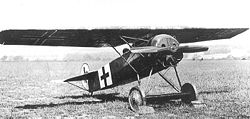Fokker D.VIII
| Fokker D.VIII | |
|---|---|

|
|
| Type: | Fighter plane |
| Design country: | |
| Manufacturer: |
Fokker |
| Commissioning: |
1918 |
| Number of pieces: |
289 |
The Fokker D.VIII (also EV ) was a German fighter aircraft in World War I in 1918. The single-seater came to the front too late to have a decisive influence on the course of the air war. The high-decker was designed by Reinhold Platz at Fokker .
history

At the end of 1917, the Allies reached such high production numbers that the Germans could no longer hold air sovereignty. In January 1918, more and more modern Allied machines reached the front, forcing the Germans on the defensive.
development
The Germans therefore announced a competition for a new hunter with the 160 hp Mercedes D III in- line engine . The clear winner was the Fokker D.VII , which went into production immediately. However, Daimler engine production was limited - in April 1918 it was therefore decided to start developing a machine with alternative engines in parallel.
Reinhold Platz had already tested a number of cantilever monoplane designs, including the low-wing V25 with the fuselage and engine of the Fokker D VI and the V21, a middle-decker with a fuselage and an engine similar to that of the Fokker D VII .
At the second comparison flight in Berlin, Fokker showed his test aircraft V.26 and V.28, the former, however, with a weak 110 HP Oberursel UR.II rotary engine . The wing layout of the V26 was similar to that of the V25, but was now mounted in a high-wing arrangement, which improved the view below. The V.28 was equipped with the Oberursel UR.III (145 HP) or Goebel Goe.III (160 HP) rotary engines. This design was able to achieve the performance of the fastest Allied fighters due to the low air resistance.
| variant | comment |
|---|---|
| V26 | Prototype of the series model, Oberursel UR II rotary engine (110 PS / 81 kW), participation in the second D-airplane competition in Berlin-Adlershof |
| V27 | V-8 engine Benz Bz IIIb (195 HP / 145 kW), participation in the second D-airplane competition in Berlin-Adlershof |
| V28 | with rotary engines Oberursel UR III (145 PS / 108 kW), Goebel Goe III (160 PS / 118 kW) or Siemens & Halske Sh.III with also 160 PS, participation in the second and third D-plane competition in Berlin-Adlershof |
| V38 | converted from V27, with armor plates on the pilot's seat, tank and engine, participation in the second D-airplane competition in Berlin-Adlershof |
| V30 | Glider, converted from V26, exhibited at the Paris Aviation Salon in 1921 |
Many machines took part in the comparison flight, with Fokker's V.26 monoplane showing outstanding performance. It received the designation Fokker EV. Only the double-decker construction Siemens-Schuckert D.IV could still beat the EV after the competition.
The D.VIII was very similar to the D.VII. It could reach 6,000 m in 16 minutes and was very maneuverable, even though the Siemens-Schuckert proved to be even more agile. Shortly before the end of the war, 400 machines with UR III and Goe III were ordered, but all machines built were ultimately equipped with the weaker UR II engines.
commitment
First World War
The first production machines reached Jagdstaffel 6 at the end of July 1918 and went to the front almost immediately. On August 17, 1918 Emil Rolff achieved an aerial victory with an EV. Two days later, however, he died of a broken wing of the machine. Two other machines also crashed with surface breaks. On August 24th the EV was withdrawn from the front. The grand pianos had been made for Fokker by the Perzina brothers . The problem with the breaks was that when it rained, the wings quickly soaked up with water and lost their stability.
However, after improvements in the treatment of the wing wood, production was resumed in October 1918 and the aircraft was now called the D.VIII . On October 24th, the first machines started for aerial combat. Soon the Allied pilots referred to the extremely dangerous EV in aerial combat as the “flying razor” . 85 machines were probably delivered, but the war ended three weeks later.
A total of 289 machines were built.
Performance comparison
Performance comparison of single-seaters in the front line at the end of the First World War :
| Surname | Country | First flight | Commissioning | Engine power | Max. speed | Takeoff mass | Armament ( MG ) | Summit height | number of pieces |
|---|---|---|---|---|---|---|---|---|---|
| Albatros D.III |
|
1916-08-01 | 1917-01-15 | 170 hp | 165 km / h | 886 kg | 2 | 5,500 m | 1352 |
| SE5a |
|
1916-11-22 | 1917-03-15 | 200 hp | 222 km / h | 880 kg | 2 | 5,185 m | 5205 |
| Sopwith Camel |
|
1916-12-31 | 1917-06-15 | 130 hp | 185 km / h | 659 kg | 2 | 5,791 m | 5490 |
| Sopwith Dolphin |
|
1917-03-23 | 1918-02-15 | 200 hp | 211 km / h | 890 kg | 2 | 6,100 m | 2072 |
| Albatros D.Va |
|
1917-04-15 | 1917-07-15 | 185 hp | 187 km / h | 937 kg | 2 | 6,250 m | 2562 |
| Palatinate D.IIIa |
|
1917-04-15 | 1917-08-15 | 180 hp | 181 km / h | 834 kg | 2 | 6,000 m | 750 |
| SPAD S.XIII |
|
1917-04-30 | 1917-05-31 | 220 hp | 222 km / h | 820 kg | 2 | 6,650 m | 8472 |
| Nieuport 28 |
|
1917-06-14 | 1918-03-15 | 160 hp | 195 km / h | 740 kg | 2 | 5,200 m | 300 |
| Fokker Dr.I |
|
1917-07-05 | 1917-09-01 | 130 hp | 160 km / h | 585 kg | 2 | 6,500 m | 420 |
| Sopwith Snipe |
|
1917-10-31 | 1918-08-30 | 230 hp | 195 km / h | 955 kg | 2 | 6,100 m | 497 |
| LFG Roland D.VIa |
|
1917-11-30 | 1918-05-15 | 160 hp | 190 km / h | 820 kg | 2 | 5,500 m | 353 |
| Siemens-Schuckert D.IV |
|
1917-12-31 | 1918-08-15 | 160 hp | 190 km / h | 735 kg | 2 | 8,000 m | 123 |
| Fokker D.VII |
|
1918-01-24 | 1918-04-15 | 180 hp | 189 km / h | 910 kg | 2 | 6,000 m | 800 |
| Fokker D.VIIF |
|
1918-01-24 | 1918-04-15 | 226 hp | 205 km / h | 910 kg | 2 | 7,000 m | 200 |
| Palatinate D.VIII |
|
1918-01-24 | 1918-09-15 | 160 hp | 190 km / h | 740 kg | 2 | 7,500 m | 120 |
| Palatinate D.XII |
|
1918-03-31 | 1918-07-15 | 160 hp | 180 km / h | 902 kg | 2 | 5,640 m | 750 |
| Fokker D.VIII |
|
1918-05-31 | 1918-07-31 | 110 hp | 204 km / h | 605 kg | 2 | 6,300 m | 289 |
Post-war use
Eight machines went to the Polish Air Force after the war and fought in the Polish-Soviet War of 1919–1920. The Red Army captured a machine. There were other aircraft in Holland, the USA, Italy, Japan and England.
Technical specifications
| Parameter | Data |
|---|---|
| crew | 1 |
| length | 5.86 m |
| span | 8.40 m |
| height | 2.80 m |
| Wing area | 10.7 m² |
| Empty mass | 405 kg |
| Takeoff mass | 605 kg |
| Top speed | 204 km / h (110 kn) |
| Service ceiling | 6300 m |
| Flight duration | 1:30 h |
| Engines | an Oberursel Ur.II with 110 hp |
| Armament | two 7.92mm LMG-08 machine guns |
Received aircraft
The body of a machine is now in the Museo dell'aeronautica Gianni Caproni in Trento , Italy . It is the world's only preserved original hull of the machine.
A complete machine is now in the Army Aviation Museum in Fort Rucker, Alabama , United States .
See also
Web links
- Fokker D.VIII. theaerodrome.com, accessed April 29, 2017 .
- Achim Engels: Replica Fokker D.VIII. Fokker-team-schorndorf.de, accessed on April 29, 2017 .
Individual evidence
- ↑ Fokker D.VIII. museocaproni.it, accessed February 28, 2018 .
- ↑ Fixed Wing. (No longer available online.) Armyaviationmuseum.org, archived from the original on December 22, 2016 ; accessed on May 2, 2013 . Info: The archive link was inserted automatically and has not yet been checked. Please check the original and archive link according to the instructions and then remove this notice.





